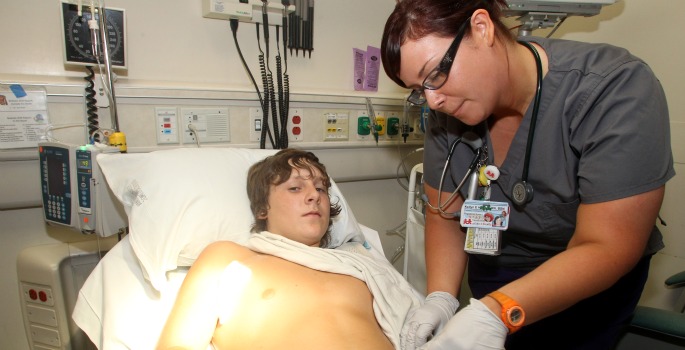
In the battle against community-associated methicillin-resistant Staphylococcus aureus (CA-MRSA) skin infections, many doctors’ offices may be choosing incorrectly when selecting oral antibiotics to treat children.
A large study conducted by Vanderbilt University Medical Center researchers, published in this week’s edition of the journal Pediatrics, demonstrates a dramatic increase in the use of trimethoprim-sulfamethoxazole or TMP-SMX (Bactrim) to counter the explosion of CA-MRSA skin boils in children across Tennessee. But another drug – clindamycin — may work better.
“These data are very revealing as to what is happening out in the trenches – that Bactrim is not as effective as clindamycin in either treating the initial infection (of skin boils) or preventing repeat infections over the next year,” said the study’s senior author, Buddy Creech, assistant professor of pediatric infectious diseases.
Understanding MRSA
CA-MRSA (commonly pronounced as MUR’-suh) is a bacterium responsible for several difficult-to-treat skin infections that have become more prevalent in recent years, causing outbreaks of infections among children and adults in close communal settings.
The retrospective study examined TennCare records for some 50,000 Tennessee children to compare outcomes of three drugs: beta-lactams (penicillin-based medications), Bactrim, or clindamycin. The drugs were prescribed for skin infections, although boils were of particular interest. A 2005 Vanderbilt study showed 70 percent to 80 percent of boils are caused by CA-MRSA.
From 2001 through 2007, the number of CA-MRSA infections seen in Vanderbilt’s adult and pediatric emergency departments increased dramatically. For instance, there were approximately 150 drained abscesses in 2001 (one every two to three days). In 2007, there were more than 1,600 abscesses that were drained (approximately four per day).
Bactrim use up, effectiveness down
Larger boils are typically drained and patients are prescribed antibiotics. But in this new study, children who had drainage procedures and were prescribed either Bactrim or a penicillin-based drug had more than twice the rate of treatment failure or recurrence when compared with children who received clindamycin. Penicillin drugs were still working well to treat non-boil-type skin infections like impetigo.
The study also found the rate of prescribing Bactrim rose dramatically in Tennessee from 2004 to 2007, from 4 percent to almost 40 percent. Doctors may have been choosing Bactrim over clindamycin for two simple reasons: it tastes better, and is cheaper.
“[rquote]When MRSA became the predominant skin bug, we all went scrambling for an oral antibiotic that would work. Bactrim looked like it worked in the lab, but it has not been put to the test in clinical trials with these skin infections in people,” Creech said.[/rquote]
Lab tests show little or no CA-MRSA resistance to Bactrim, but Derek Williams, instructor of pediatrics and lead author of the current study, says MRSA may get around the drug by borrowing tools from a patient’s own body.
“Clindamycin had already been in use for serious MRSA infections of the bone and other tissues, and we know it works well, yet we only saw a modest increase in its use for these minor skin infections,” Williams said.
Williams and Creech say this study is a preliminary first step since it takes a long time to do the prospective research that will change the standard of care. Vanderbilt is participating in such a trial.
“Meanwhile, this study is strongly suggestive and has good evidence behind it that physicians should stop and think twice. Bactrim may not be the best choice for skin boils,” Williams said.